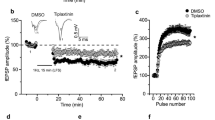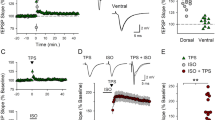Abstract
Protein phosphorylation is the main signaling system known to trigger synaptic changes underlying long-term potentiation (LTP). The timing of these phosphorylations plays an essential role to maintain the potentiated state of synapses. However, in mice a simultaneous analysis of phosphorylated proteins during early-LTP (E-LTP) has not been thoroughly carried out. Here we described phosphorylation changes of αCaMKII, ERK1/2, PKB/Akt and CREB at different times after E-LTP induced at Schaffer collateral/commissural fiber-CA1 synapses by 1 s 100 Hz tetanic stimulation in mouse hippocampal slices. We found that phosphorylation levels of all the molecules examined rapidly increased after tetanisation and remained above the basal level up to 30 min. Notably, we observed a sustained increment in the phosphorylation level of Akt at Ser473, whereas the phosphorylation level of Akt at Thr308 was unchanged. Unexpectedly, we also detected a marked increase of CREB target genes expression levels, c-fos, Egr-1 and exon-III containing BDNF transcripts. Our findings, besides providing a detailed timing of phosphorylation of the major kinases involved in E-LTP in mice, revealed that a modest LTP induction paradigm specifically triggers CREB-mediated gene expression.



Similar content being viewed by others
References
Bliss TV, Collingridge GL (1993) A synaptic model of memory: long-term potentiation in the hippocampus. Nature 361:31–39
Malenka RC, Nicoll RA (1999) Long-term potentiation: a decade of progress? Science 285:1870–1874
Pittenger C, Kandel ER (2003) In search of general mechanisms for long-lasting plasticity: aplysia and the hippocampus. Philos Trans R Soc Lond B Biol Sci 358:757–763
Lynch MA (2004) Long-term potentiation and memory. Physiol Rev 84:87–136
Citri A, Malenka RC (2007) Synaptic plasticity: multiple forms, functions, and mechanisms. Neuropsychopharmacology 33:18–41
Silva AJ, Kogan JH, Frankland PW et al (1998) CREB and memory. Annu Rev Neurosci 21:127–148
Kandel ER (2001) The molecular biology of memory storage: a dialogue between genes and synapses. Science 294:1030–1038
Dudai Y (2004) The neurobiology of consolidation, or, how stable is the engram? Ann Rev Psychol 55:51–86
Kelleher RJ, Govindarajan A, Tonegawa S (2004) Translational regulatory mechanisms in persistent forms of synaptic plasticity. Neuron 44:59–73
Klann E, Dever TE (2004) Biochemical mechanisms for translational regulation in synaptic plasticity. Nat Rev Neurosci 5:931–942
Sutton MA, Schuman EM (2006) Dendritic protein synthesis, synaptic plasticity, and memory. Cell 127:49–58
Yuste R, Majevska A, Holthoff K (2000) From form to function: calcium compartmentalization in dendritic spines. Nat Neurosci 3:653–659
Lisman J, Schulman H, Cline H (2002) The molecular basis of CaMKII function and behavioural memory. Nat Rev Neurosci 3:175–190
Barria A, Muller D, Derkach V et al (1997) Regulatory phosphorylation of AMPA-Type glutamate receptors. Science 276:2042–2045
Ouyang Y, Rosenstein A, Kreiman G et al (1999) Tetanic stimulation leads to increased accumulation of Ca (2+)/calmodulin-dependent protein kinase II via dendritic protein synthesis in hippocampal neurons. J Neurosci 19:7823–7833
Giese KP, Fedorov NB, Filipkowski RK et al (1998) Autophosphorylation at Thr286 of the alpha calcium-calmodulin kinase II in LTP and learning. Science 279:870–873
Lengyel I, Voss K, Cammarota M (2004) Autonomous activity of CaMKII is only transiently increased following the induction of long-term potentiation in the rat hippocampus. Eur J Neurosci 20(11):3063–3072
Cooke SF, Wu J, Plattner F et al (2006) Autophosphorylation of alphaCaMKII is not a general requirement for NMDA receptor-dependent LTP in the adult mouse. J Physiol 574:805–818
Hardingham N, Glazewski S, Pakhotin P et al (2003) Neocortical long-term potentiation and experience-dependent synaptic plasticity require α-calcium/calmodulin-dependent protein kinase II autophosphorylation. J Neurosci 23:4428–4436
Adams JP, Sweatt JD (2002) Molecular psychology: roles for the ERK MAP kinase cascade in memory. Annu Rev Pharmacol Toxicol 42:135–163
Kasahara J, Fukunaga K, Miyamoto E (2001) Activation of calcium/calmodulin-dependent protein kinase IV in long term potentiation in the rat hippocampal CA1 region. J Biol Chem 276:24044–24050
Winder DG, Martin KC, Muzzio I (1999) ERK plays a regulatory role in induction of LTP by theta frequency stimulation and its modulation by beta-adrenergic receptors. Neuron 24:715–726
Schmitt JM, Guire ES, Saneyoshi T et al (2005) Calmodulin-dependent kinase kinase/calmodulin kinase I activity gates extracellular-regulated kinase-dependent long-term potentiation. J Neurosci 25(5):1281–1290
Pollak DD, Scharl T, Leisch F et al (2005) Strain-dependent regulation of plasticity-related proteins in the mouse hippocampus. Behav Brain Res 16:240–246
Horwood JM, Dufour F, Laroche S (2006) Signalling mechanisms mediated by the phosphoinositide 3-kinase/Akt cascade in synaptic plasticity and memory in the rat. Eur J Neurosci 23:3375–3384
Giovannini MG, Blitzer RD, Wong T et al (2001) Mitogen-activated protein kinase regulates early phosphorylation and delayed expression of Ca22+/calmodulin-dependent protein kinase II in long-term potentiation. J Neurosci 21:7053–7062
Selcher JC, Weeber EJ, Christian J et al (2003) A role for ERK MAP kinase in physiologic temporal integration in hippocampal area CA1. Learn Mem 10:26–39
Pittenger C, Huang YY, Paletzki RF et al (2002) Reversible inhibition of CREB/ATF transcription factors in region CA1 of the dorsal hippocampus disrupts hippocampus-dependent spatial memory. Neuron 34:447–462
Balschun D, Wolfer DP, Gass P et al (2003) Does cAMP response element-binding protein have a pivotal role in hippocampal synaptic plasticity and hippocampus-dependent memory? J Neurosci 23(15):6304–6314
Gonzales GA, Montminy MR (1989) Cyclic AMP stimulates somatostatin gene transcription by phosphorylation of CREB at serine 133. Cell 59:675–680
Hardingham GE, Arnold FJ, Bading H (2001) A calcium microdomain near NMDA receptors: on switch for ERK dependent synapse-to-nucleus communication. Nat Neurosci 4:565–566
Wu GY, Deisseroth K, Tsien RW (2001) Activity-dependent CREB phosphorylation: convergence of a fast calmodulin kinase pathway and a slow, less-sensitive mitogen-activated protein kinase pathway. Proc Natl Acad Sci USA 98:2808–2813
Kelly A, Lynch MA (2000) Long-term potentiation in dentate gyrus of the rat is by the phosphoinositide 3-kinase inhibitor, wortmannin. Neuropharmacology 39:643–651
Lin CH, Yeh SH, Lin CH et al (2001) A role for the PI-3 kinase signaling pathway in fear conditioning and synaptic plasticity in the amygdale. Neuron 31:841–851
Sanna PP, Cammalleri M, Berton F et al (2002) Phosphatidylinositol 3-kinase is required for the expression but not for the induction or the maintenance of long-term potentiation in the hippocampal CA1 region. J Neurosci 22:3359–3365
Franke TF, Kaplan DR, Cantley LC (1997) PI3K: downstream AKTion blocks apoptosis. Cell 88:435–437
Chan TO, Rittenhouse SE, Tsichlis PN (1999) AKT/PKB and other D3 phosphoinositide-regulated kinases: kinase activation by phosphoinositide-dependent phosphorylation. Annu Rev Biochem 68:965–1014
Soderling TR, Derkach VA (2000) Postsynaptic protein phosphorylation and LTP. Trends Neurosci 23:75–80
Huang YY, Kandel ER (1994) Recruitment of long-lasting and protein kinase A-dependent long-term potentiation in the CA1 region of hippocampus requires repeated tetanisation. Learn Mem 1:74–82
Opazo P, Watabe AM, Grant SGN et al (2003) Phosphatidylinositol 3-kinase regulates the induction of long-term potentiation through extracellular signal-related kinase-independent mechanisms. J Neurosci 23:3679–3688
Alessi DR, Andjelkovic M, Caudwell B et al (1996) Mechanism of activation of protein kinase B by insulin and IGF-1. EMBO J 15:6541–6551
Bito H, Deisseroth K, Tsien RW (1996) CREB phosphorylation and dephosphorylation: a Ca(2+)- and stimulus duration-dependent switch for hippocampal gene expression. Cell 87:1203–1214
Tao X, Finkbeiner S, Arnold DB et al (1998) Ca2 influx regulates BDNF transcription by a CREB family transcription factor-dependent mechanism. Neuron 20:709–726
Impey S, Mark M, Villacres EC (1996) Induction of CRE-mediated gene expression by stimuli that generate long-lasting LTP in area CA1 of the hippocampus. Neuron 16:973–982
Deisseroth K, Bito H, Tsien RW (1996) Signaling from synapse to nucleus: postsynaptic CREB phosphorylation during multiple forms of hippocampal synaptic plasticity. Neuron 16:89–101
Impey S, Obrietan K, Wong ST et al (1998) Cross talk between ERK and PKA is required for Ca2+ stimulation of CREB-dependent transcription and ERK nuclear translocation. Neuron 21:869–883
Jones MW, French PJ, Bliss TV et al (1999) Molecular mechanisms of long-term potentiation in the insular cortex in vivo. J Neurosci 19:RC36
Acknowledgments
This study was supported in part by the Italian Ministry of Health—Research Project Neurodegenerative Diseases, ex art. 56: “Role of Herpes Simplex-I infection in the pathogenesis of Alzheimer’s Disease and transmissible spongiform encephalopathies”.
Author information
Authors and Affiliations
Corresponding author
Rights and permissions
About this article
Cite this article
Racaniello, M., Cardinale, A., Mollinari, C. et al. Phosphorylation Changes of CaMKII, ERK1/2, PKB/Akt Kinases and CREB Activation During Early Long-Term Potentiation at Schaffer Collateral-CA1 Mouse Hippocampal Synapses. Neurochem Res 35, 239–246 (2010). https://doi.org/10.1007/s11064-009-0047-0
Received:
Accepted:
Published:
Issue Date:
DOI: https://doi.org/10.1007/s11064-009-0047-0




